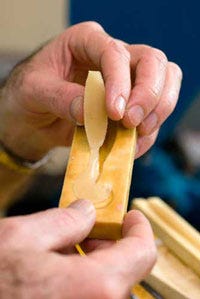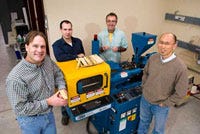An eco-friendly fish tale
A Wisconsin inventor had an idea to create stronger lures that wouldn’t pollute the environment, and turned it into reality with the help of staff, students, and resources from a few nearby universities.
July 13, 2009
A Wisconsin inventor had an idea to create stronger lures that wouldn’t pollute the environment, and turned it into reality with the help of staff, students, and resources from a few nearby universities.
Fishing lures come in all shapes and sizes, and have been used for decades to entice fish to take a bite. But the plasticizer used in the PVC to keep the realistic minnows flexible contains phthalates, which have been under attack for potential health risks, And since these lures are flexible, they are easily torn off in weeds or bitten off entirely, and end up being released into the environment.
|
“If you go into a sporting goods store, virtually every soft plastic fishing lure on the wall is lost in the environment,” says Madison-area entrepreneur Ben Hobbins. “Add in 60 years of soft-lure waste release and, for the environment, that’s a staggering thought.”
Ice fisherman Hobbins is among the nation’s top 10 inventors featured in the June issue of Popular Science magazine, and he devised flexible yet eco-friendly lures in November 2005 after fumbling with cold hands to replace torn soft-bait lures. Hobbins started working on a patent, using patent resources at the UW-Madison engineering library, product assessment resources from the UW-Whitewater Wisconsin Innovation Service Center, and product development and prototyping information from the UW-Extension Wisconsin Entrepreneurs Network. After entering his business plan in the Wisconsin Governor’s Business Plan Contest and finishing in the top 10 in the advanced manufacturing category, Hobbins took his idea to Phil Kim, an assistant professor at the UW-Madison Business School, who teaches a course in entrepreneurship.
Students write a business plan for a local business owner in the class, and a group of undergraduates signed on for Hobbins’ project. Information was gathered on the soft-lure market by the students, and through researching the existing polymer manufacturing technologies, they decided to contact Tim Osswald, a UW-Wisconsin professor of mechanical engineering and codirector of the UW-Madison Polymer Engineering Center. Osswald was intrigued by the project, and established a research partnership through the Polymer Engineering Center withHobbins. Graduate students helped Osswald and Hobbins develop rapid prototypes to create working models in time for a sportfishing convention.
The material used in the new lures uses microfibers embedded in the soft plastic, which can sustain 93 lb of tensile strain. “They’re placed in such a way that you still have the flexible lure, but you can’t rip it,” says Osswald. “Now, they’re stiffer to the pull, if you stretch them—but they’re still flexible and deliver the desired performance.”
The lures sell for a comparable price to soft plastic, and can be found in stores such as Bass Pro Shops and Cabela’s. “Without development collaboration by UW-Madison’s Polymer Engineering Center, development of the IronClads project would have been nearly impossible,” says Hobbins. “I owe Tim, his team, and the university much in our success.”
About the Author(s)
You May Also Like





